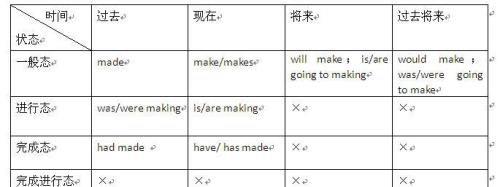中考英语八大时态详解及答案(中考英语八大时态一览表)
导语:中考英语八大时态详解
时态指的是一定的时间里动作所处状态,时态是时间与状态的紧密结合,因此每一种时态都少不了时间与状态两个概念。时间可分为过去、现在、将来、过去将来四种,状态有一般态、进行态、完成态及完成进行态四种。把时间与状态用表格对应起来,初中阶段只要求我们掌握8种时态的运用,这8种时态构成以动词make为例如下表:

从上表可以看出,一般态中考要求掌握四个时间,即分别是:一般过去,时一般现在时,一般将来时和过去一般将来时(简称过去将来时)。它们的具体用法如:
(一).一般过去时:
1.概念:过去某个时间里发生的动作或状态;过去习惯性、经常性的动作、行为。
2.时间状语:ago, yesterday, the day before yesterday, last week(year, night, month…), in 1989, just now, at the age of 5, one day, long long ago, once upon a time, this morning
3.基本结构:
①be动词;was/were …
②行为动词 :动词的过去式
4.否定形式:①was/were+not;② didn’t +动词原形
5.一般疑问句:①was或were放于句首;② Did +…+动词原形……?
(二).一般现在时:
1.概念:经常、反复发生的动作或行为及现在的某种状况。也可表客观规律以及在时间,条件状语从句中表将来时(主将从现)
2.时间状语:always, usually, often, sometimes, every week (day, year, month…), once a week, on Sundays,
3.基本结构:①be动词;am/is/are ②行为动词 :动词原形、第三人称单数。
4.否定形式:①am/is/are+not;② don’t /doesn’t +动词原形+……
5.一般疑问句:①把be动词放于句首;② Do/Does +…+动词原形+…?
(三)一般将来时:
1.概念:表示将要发生的动作或存在的状态及打算、计划或准备做某事。
2.时间状语:tomorrow, next day(week, month, year ) ,soon, in+一段时间, by…,the day after tomorrow, this evening ,tonight
3.基本结构:1).am/is/are/going to + do;2).will/shall + do.
3).用现在进行时表示将来,动词come, go ,start,leave ,fly,move ,begin ,get ….
4).当主句为一般将来时,由if ,as soon as ,until, when ,before, after, unless 引导的状语从句中用一般现在时代替一般将来时。
4.否定形式:①was/were + not; ②在行为动词前加didn't,同时还原行为动词。
5.一般疑问句:①be放于句首;②will/shall提到句首。
(四)过去将来时:
1.概念:立足于过去某一时刻,从过去看将来,常用于宾语从句中。
2.时间状语:the next day(morning, year…),the following month(week…), by then ,
3.基本结构:①was/were/going to + do;②would/should + do.
4.否定形式:①was/were/not + going to + do;②would/should + not + do.
5.一般疑问句:①was或were放于句首;②would/should 提到句首。
进行态只要求掌握两个时间,即过去进行时与现在进行时。
(五)过去进行时:
1.概念:表示过去某段时间或某一时刻正在发生或进行的行为或动作。
2.时间状语:at this/that time yesterday, at that time ,at sixyesterday evening ,from eight o’clock to nine o’clock last night 或以when/while引导的时间状语(过去进行时+when+一般过去时/ 一般过去时+while +过去进行时/过去进行时+while +过去进行时)。
3.基本结构: was/were+doing
4.否定形式: was/were + not + doing.
5.一般疑问句: 把was或were放于句首。
(六)现在进行时:
1.概念:表示现阶段或说话时正在进行的动作及行为。
2.时间状语:now, at this time, these days, look,listen ,can you see? Can’t you see ?之类的暗示语。
3.基本结构: am/is/are+doing
4.否定形式: am/is/are+not+doing.
5.一般疑问句: Is /Are …+doing sth ?
完成态只要求我们掌握过去完成时与现在完成时,完成进行态不要求掌握。
(七)过去完成时:
1.概念:以过去某个时间为标准,在此以前发生的动作或行为,或在过去某动作之前完成的行为,即“过去的过去”。
2.时间状语:1).before+过去时间,by+ 过去时间, by the end of last year(term, month…)2).by the time +从句(一般过去时),主句(过去完成时)3).用于由when ,after , before 引导的时间状语从句中,前后两动作都发生在过去。
过去完成时+when/before +一般过去时
一般过去时+after +过去完成时
4).用于宾语从句中。
3.基本结构:
had + done.
4.否定形式:
had + not + done.
5.一般疑问句:
把had放于句首。
(八)现在完成时:
1.概念:过去发生或已经完成的动作对现在造成的影响或结果,或从过去已经开始,持续到现在的动作或状态。
2.时间状语:recently, lately, since…for…,in the past few years, already ,yet ,never ,ever, just, before, so far ,once, twice etc.
3.基本结构: have/has + done
4.否定形式: have/has + not +done.
5.一般疑问句: 把have或has放于句首。
6.反义疑问句: 直接用has /have 进行反问
7.注意:
1).have been to /have gone to /have been in 的区别
have been to +地点 表示曾经去过某地,现人已返回。(once ,twice ….)
have gone to +地点 表示人已去了某地,人还未返回。(where is sb ?)
have been in +地点 表示在某地呆多长时间。(for…../ since …..)
2).与时间段连用时,短暂性动词应改为相应的延续性动词。
Come/go to ------ be at /in leave ----be away from buy ----have borrow /lend -----keep open ---be open close---be closed die---dead start/begin ----be on join—--be in /be a member of /be a soldier become –be make friend ---be friend get up ---be up
fall asleep ---be asleep catch a cold – have a cold reach/get/arrive---stay/be
3).现在完成时的四种句型:
A).主语+短暂性动词的过去式+ 时间+ago
B).主语+have/has +延续性动词的过去分词+for…./since …. ago .
C).It’s +时间段+since +短暂性动词的过去式
D).时间段+has passed +since +短暂性动词的过去式
免责声明:本站部份内容由优秀作者和原创用户编辑投稿,本站仅提供存储服务,不拥有所有权,不承担法律责任。若涉嫌侵权/违法的,请反馈,一经查实立刻删除内容。本文内容由快快网络小梓创作整理编辑!